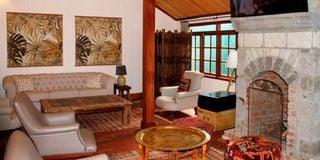Premium
Revisiting Karen Blixen’s places

A refurbished lounge in the old Swedo House.
It was very much a Karen Blixen day. No, this is not one of my ghost stories – though I think Karen would have enjoyed herself, too. Last Sunday really was a sun day, so my wife and I fancied a relaxed lunch at the Karen Blixen Coffee Garden – an old favourite place.
However, we were in for a surprise. First, there was the new signboard, right in front of us as we turned in off Karen Road. It announced the Karen Blixen Garden Restaurant and Bar – and no mention of the Tamambo or Tamarind Restaurants. As we parked, we were told there were renovations underway and we were led to the left where the guest cottages are – to tables set out around the swimming pool.
All was revealed by Lillian, the manager, the Tamarind Group’s lease had run out; they have opened at what was the Dari Restaurant on Ngong Road. The whole Karen Blixen complex is now in the hands of the Karen Blixen Group, which also has the Karen Blixen Camp in the Mara North Conservancy.
It’s not really fair to judge the new place yet; quite a lot of make-shifting is going on. The food was good – I had a red snapper filet marinated with garlic and herbs and served with lemon butter sauce, sautéed greens and mashed potatoes. It was rather pricey at Sh2,000. And the wine was very pricey: two Prosecco by the glass are on offer – each of them at Sh1,500. Around the pool, the young Karen families outnumbered the guests from the cottages. They will be more aware of the local wine prices. I guess some of them, like me, have complained.
We had a good chat with Lillian about the ongoing renovations to the main garden restaurant and how they will use the historic Grogan House, which was moved there stone by stone. We were in what used to be called Swedo House, owned by the company that sold out to the Blixens. The old house, the walls of which were mud and chicken wire, became the home of the Blixen’s coffee farm manager.
I looked for a grainy photograph that used to hang on the back wall of the veranda. I couldn’t find it. The faces of those Swedo Company men were the faces of working men – men who were doing a tough job. I remember how Sir Michael Blundell – himself a settler farmer – told me how much he resented the focus there has been on the Happy Valley set of aristocratic and self-indulgent settlers. ‘Most of us farmers had opened up farms out of the bush,’ he said. ‘And we survived the Depression years before the Second World War. For us, life was often hard.’
The redesigned furnishing and décor of Swedo House are very tasteful and elegant. It will be enjoyed as a reception and lounge for the tourists who stay in the cottages. But it is no longer like the house that working men lived in.
We went on to the Karen Blixen Museum. There, a lot of effort has been made to ensure that this Bogani House, the home of Karen Blixen for many years, is as it was in her own time.
We were impressed with Patrick, our guide. It was good to have a conversation with someone who had not only done his research but also enjoyed talking about it: Karen’s unhappy marriage to Baron Bror von Blixen-Finecke; her love for the English hunter, Denys Finch Hatton; her struggle to grow coffee on a land not suitable for coffee; her relationship with her staff. That was as we sat in the shade of garden trees before we took the tour of the building.
Even though we had been to the museum a number of times over the years, it was a fascinating afternoon. Next time we will try the museum’s nature trail through the woods.
John Fox is Chairman of iDC Email: [email protected]





